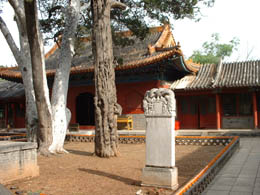
To preserve precious Buddhist murals in western Beijing's Fahai Temple, a replication project that started last September is currently underway, a source from the temple management office said on June 27.
Situated at the foot of the south side of Cuiwei Mountain, 20 km from downtown Beijing, the temple with an area of 20,000 sq m was constructed between 1439-1443 during the Ming Dynasty (1368-1644) and funded by the emperor's trusted eunuch Li Tong.
It contains amazing Buddhist murals with a history of over 560 years. A great many vivid and spectacular murals were painted on the walls of the main hall of the temple by royal artists. However, only 10 well-preserved murals covering just over 236 sq m remain inside the main hall -- the Hall of Sakyamuni.
To reduce any further deterioration of the murals the replicas, produced using collotype printing techniques, will be on display for the general public next year in other halls of the temple. As a protective measure, by then the admission fee for the authentic murals is likely to go up.
As the years go by, the colors in the murals have begun to fade owing to the corrosive acid content in the air. Since 2003 all lamps in the main hall were shut off. Meanwhile, the windows were shuttered to prevent further damage to the murals from light. Tourists then have to appreciate these treasures in the darkness using electric torches while being accompanied by a member of staff.
The government has given approval for 10 million yuan (US$1.25 million) to be spent on the renovation of the temple. Craftsmen are currently restoring the walls on which the murals were painted.
Due to the use of valuable painting materials and elaborate brush techniques the murals of Fahai Temple hold an important position in the aesthetic history of China.
The best painting is considered to be the image of Guanyin (Avalokitesvara), who is watching the moon in the water with her half bared chest ornamented with pearls and jade, and a light transparent gauze draped over the shoulders -- looking beautiful, affable, dazzling and divine.
Though not as famous as the Dunhuang Frescos in Gansu Province and the Yongle Murals in Shanxi Province, with their very special artistic charm the murals of Fahai Temple draw a large number of visitors each year. Some artists have gone as far as to say they could match the beauty of renaissance murals in Europe.
The preservation of these murals is thanks to the endeavors of two people. One is Xu Beihong (1895-1953), a famous painter who first discovered the value of the murals, reported their importance to Beijing authorities and asked for their protection.
The other is Wu Xiaolu, a former apprentice in an antique shop and then a dormitory custodian at a middle school occupying the site of Fahai Temple during the "Great Cultural Revolution" period (1966-76). When the "Red Guards" came to the temple to cast away the "four olds" (old ideas, old culture, old customs, and old habits), Wu, holding the key to the main hall then, deliberately led them to topple down several arhat statues, ensuring the murals hidden in the dark remained untouched by them. Wu kept protecting the murals voluntarily for over two decades until his last days.
(China.org.cn by Wang Zhiyong, July 4, 2006)
|

